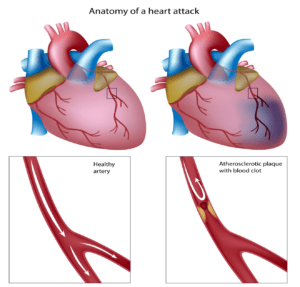
Heart attack, technically known as myocardial infarction (MI) or acute myocardial infarction (AMI), occurs due to diminution of blood supply to a part of the heart, causing that particular heart cells to die. Heart attack most commonly occurs due to occlusion (blockage) of a coronary artery following the rupture of a vulnerable atherosclerotic plaque. It results into restriction in blood supply and oxygen shortage ensues. If this situation is left as such without treatment for a sufficient period of time, it can cause damage or death (infarction) of heart muscle tissue (myocardium).
Risk Factors
Unwanted buildup of fatty deposits (atherosclerosis) that narrows arteries throughout your body, including arteries to your heart, is contributed by certain factors. It is possible to improve or eliminate many of these risk factors as this decreases your chances of having a first or subsequent heart attack.
Risk factors for heart attack include:
- Age. Heart attack is more common in men who are 45 or older and women who are 55 or older.
- Smoking. Active smoking and/or long-term exposure to secondhand smoke damages the interior walls of arteries allowing deposits of cholesterol and other substances to collect and slow blood flow. These arteries include arteries of your heart, along with other arteries. Risk of deadly blood clots forming and causing a heart attack is also increased by smoking.
- Diabetes. Diabetes, a disease where body is unable to adequately produce insulin or respond to insulin need properly, occurs more often in middle age and among overweight people. Patients with diabetes are at a great risk of a heart attack.
- Blood pressure. Increased blood pressure over years damages arteries that feed your heart by accelerating atherosclerosis. As you age, the risk of high blood pressure increases, but the main culprits for most people are eating a diet too high in salt and being overweight.
- Hypercholesterolemia. Deposits occurring in the arterial walls mainly consist of cholesterol, and can narrow arteries throughout your body, including those that supply your heart. High blood levels of bad cholesterol increases your risk of a heart attack. Low-density lipoprotein (LDL) cholesterol (the “bad” cholesterol) is most likely to narrow arteries. This LDL increases due to a diet high in saturated fats and cholesterol. It is undesirable to have a high level of triglycerides, a type of blood fat related to your diet. But, HDL, a good cholesterol, which helps the body clean up excess cholesterol, is desirable and lowers your risk of heart attack.
- Family history of heart attack. In case any of your sibling, parents or grandparents have had a heart attacks, you may be at increased risk. You and your family might be genetically predisposed to increased unwanted blood cholesterol levels. High blood pressure also can run in families.
- No or less physical activity. High blood cholesterol levels and obesity are caused by an inactive lifestyle. Regular aerobic activity leads to better cardiovascular fitness, which decreases overall risk of heart attack. Exercise is also beneficial in lowering high blood pressure.
- Obesity. Being overweight leads to high proportion of body fat (a body mass index of 30 or higher). Risk of heart attack is increased by being overweight as it’s associated with high blood cholesterol levels, high blood pressure and diabetes.
- Stress. Inappropriate response to stress can increase your risk of a heart attack. Being constantly under stress leads to overeating or smoking or drug abuse from nervous tension. Too much stress, as well as anger, can also raise your blood pressure.
- Illicit drug use. Drug abuse with cocaine or amphetamines can trigger a spasm of your coronary arteries that can cause a heart attack.
